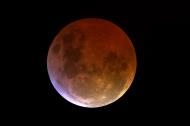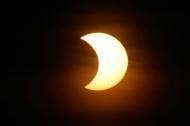What is a Supermoon and When is the Next One?
A Supermoon is a full Moon or a new Moon at its closest point to Earth; also called perigee. A Super Full Moon looks around 12 to 14% bigger than its counterpart, the Micromoon.

A Supermoon can be full or new.
A Super Full Moon is visible to us, but a Super New Moon is not.
©bigstockphoto.com/ duallogic
Perigee and Apogee
The Moon's orbit around the Earth is not a perfect circle, but elliptical, with one side closer to the Earth than the other.
The point on the Moon's orbit closest to the Earth, is called the perigee and the point farthest away is the apogee.
238,000 Miles on Average
This means that the distance between the Moon and Earth varies throughout the month and the year. On average the distance is about 238,000 miles or 382,900 kilometers.
Super Full Moon and Super New Moon

When a full Moon coincides with being closest to Earth, it is called a Super Full Moon. A new Moon that takes places when the Moon is at its perigee is known as a Super New Moon.
A Micromoon, on the other hand, is when a full or a new Moon is farthest from the Earth (apogee). It's also sometimes known as a Minimoon, Mini Full Moon or a Mini New Moon.
When's the next Super Full Moon & Super New Moon?
Not an Official Name
Supermoon is not an official astronomical term. It was first coined by an astrologer, Richard Nolle, in 1979. He defined it as ‘a new or a full Moon that occurs when the Moon is at or near (within 90% of) its closest approach to Earth in its orbit’. It is not clear why he chose the 90% cut off in his definition.
There are currently no official rules as to how close or far the Moon must be to qualify as a Supermoon or a Micro Moon. Different outlets use different definitions. Due to this, a full Moon classified as a Supermoon by one source may not qualify as a Super Full Moon by another.
Supermoon Definition
timeanddate.com uses the following definition:
- Supermoon: A full or new Moon that occurs when the Moon is less than 360,000 kilometers (ca. 223,694 miles) from the center of the Earth.
- Micromoon: A full Moon or new Moon that takes place when the Moon is farther than 400,000 kilometers (ca. 248,548 miles) from the Earth.
Technical Name: Perigee-syzygy
The technical term for a supermoon is perigee-syzygy of the Earth-Moon-Sun system. In astronomy, the term syzygy refers to the straight-line configuration of three celestial bodies.
When the Moon is close to the lunar nodes of its path during syzygy, it causes a total solar eclipse or a total lunar eclipse
Looks Bigger and Brighter

Because it's so close to Earth, a Super Full Moon looks about 7% bigger than an average full Moon. When compared to a Micromoon, it looks about 12-14% larger.
A Super Full Moon also looks about 30% brighter than a Micro Full Moon and about 16% brighter than an average full Moon.
Full Moons that occur before and after a Super Full Moon tend to also look bigger and brighter than an average full Moon. These full Moons are also often called Supermoons by many sources.
Biggest During Winter
Supermoons during Northern Hemisphere winter months tend to look larger than Supermoons that occur during the rest of the year. At this time of the year, the Earth is closer to the Sun. Because of this, the Sun's gravity pulls the Moon closer to Earth, making any winter Super Full Moons look bigger than summer Perigee Moons.
Best at Moonrise
The best time to enjoy a Super Full Moon is after moonrise, when the Moon is just above the horizon, weather permitting. At this position, a Supermoon will look bigger and brighter than when it's higher up in the sky because you can compare the apparent size of the Supermoon with elements in the landscape – hills, foliage and buildings. This effect is popularly called the Moon illusion.
Taking pictures of a Supermoon
Tidal Effects

The tides on Earth are mostly generated by the Moon’s gravitational pull from one side of the Earth to the other. The Moon’s gravity can cause small ebbs and flows in the continents called land tides or solid Earth tides. These are greatest during the full and new Moons because the Sun and Moon are aligned on the same or opposite sides of the Earth.
Natural Disaster Trigger?
Although the Sun and the Moon’s alignment cause a small increase in tectonic activity, the effects of the Supermoon on Earth are minor. Many scientists have conducted studies and haven’t found anything significant that can link the Super Moon to natural disasters.
According to NASA, the combination of the Moon being at its closest and at full Moon, should not affect the internal energy balance of the Earth since there are lunar tides every day. There is a small difference in tidal forces exerted by the Moon’s gravitational pull at lunar perigee. However, the difference is too small to overcome the larger forces within the planet.
Upcoming Supermoons
| Year | Date |
|---|---|
| 2016 | Monday, November 14 |
| 2017 | Sunday, December 3 |
| 2018 | Monday, January 1 |

All about the Moon
- The Moon Phases
- What Is a Supermoon?
- What Is a Micro Moon?
- Is a Blue Moon blue?
- The Moon's Orbit
- What Is a Black Moon?
- What are Moonbows?
- Full Moon Names
Moon Phases In Your City
Moonrise & Moonset Times
Eclipse Lookup
Weather Look-Up
Day & Night World Map App

Watch daylight move across the planet... More






Share this page / Follow us on:
Visit us on: